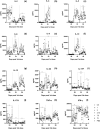Preclinical immunogenicity assessment of a cell-based inactivated whole-virion H5N1 influenza vaccine
- PMID: 36249527
- PMCID: PMC9518664
- DOI: 10.1515/biol-2022-0478
Preclinical immunogenicity assessment of a cell-based inactivated whole-virion H5N1 influenza vaccine
Abstract
In influenza vaccine development, Madin-Darby canine kidney (MDCK) cells provide multiple advantages, including large-scale production and egg independence. Several cell-based influenza vaccines have been approved worldwide. We cultured H5N1 virus in a serum-free MDCK cell suspension. The harvested virus was manufactured into vaccines after inactivation and purification. The vaccine effectiveness was assessed in the Wuhan Institute of Biological Products BSL2 facility. The pre- and postvaccination mouse serum titers were determined using the microneutralization and hemagglutination inhibition tests. The immunological responses induced by vaccine were investigated using immunological cell classification, cytokine expression quantification, and immunoglobulin G (IgG) subtype classification. The protective effect of the vaccine in mice was evaluated using challenge test. Antibodies against H5N1 in rats lasted up to 8 months after the first dose. Compared with those of the placebo group, the serum titer of vaccinated mice increased significantly, Th1 and Th2 cells were activated, and CD8+ T cells were activated in two dose groups. Furthermore, the challenge test showed that vaccination reduced the clinical symptoms and virus titer in the lungs of mice after challenge, indicating a superior immunological response. Notably, early after vaccination, considerably increased interferon-inducible protein-10 (IP-10) levels were found, indicating improved vaccine-induced innate immunity. However, IP-10 is an adverse event marker, which is a cause for concern. Overall, in the case of an outbreak, the whole-virion H5N1 vaccine should provide protection.
Keywords: H5N1; MDCK cells; cellular immune response; humoral immune response; vaccine.
© 2022 Zhegang Zhang et al., published by De Gruyter.
Conflict of interest statement
Conflict of interest: Authors state no conflict of interest.
Figures











Similar articles
-
Protective immunity against influenza H5N1 virus challenge in mice by intranasal co-administration of baculovirus surface-displayed HA and recombinant CTB as an adjuvant.Virology. 2008 Oct 25;380(2):412-20. doi: 10.1016/j.virol.2008.08.002. Epub 2008 Sep 10. Virology. 2008. PMID: 18786689
-
The safety and immunogenicity of a cell-derived adjuvanted H5N1 vaccine - A phase I randomized clinical trial.J Microbiol Immunol Infect. 2019 Oct;52(5):685-692. doi: 10.1016/j.jmii.2019.03.009. Epub 2019 May 18. J Microbiol Immunol Infect. 2019. PMID: 31255574 Clinical Trial.
-
The Madin-Darby canine kidney cell culture derived influenza A/H5N1 vaccine: a phase I trial in Taiwan.J Microbiol Immunol Infect. 2013 Dec;46(6):448-55. doi: 10.1016/j.jmii.2012.08.002. Epub 2012 Sep 27. J Microbiol Immunol Infect. 2013. PMID: 23022464 Clinical Trial.
-
New strategies for the development of H5N1 subtype influenza vaccines: progress and challenges.BioDrugs. 2011 Oct 1;25(5):285-98. doi: 10.1007/BF03256169. BioDrugs. 2011. PMID: 21942913 Review.
-
Prepandemic influenza vaccine H5N1 (split virion, inactivated, adjuvanted) [Prepandrix]: a review of its use as an active immunization against influenza A subtype H5N1 virus.BioDrugs. 2008;22(5):279-92. doi: 10.2165/00063030-200822050-00001. BioDrugs. 2008. PMID: 18778110 Review.
References
-
- Chan PK. Outbreak of avian influenza A(H5N1) virus infection in Hong Kong in 1997. Clin Infect Dis. 2002;34(Suppl 2):S58–64. - PubMed
-
- Hui DS. Review of clinical symptoms and spectrum in humans with influenza A/H5N1 infection. Respirology. 2008;13(Suppl 1):S10–3. - PubMed
-
- Duong TN, Thiem VD, Anh DD, Cuong NP, Thang TC, Huong VM, et al. A Phase 2/3 double blinded, randomized, placebo-controlled study in healthy adult participants in Vietnam to examine the safety and immunogenicity of an inactivated whole virion, alum adjuvanted, A(H5N1) influenza vaccine (IVACFLU-A/H5N1). Vaccine. 2020;38(6):1541–50. - PubMed
-
- Sabarth N, Savidis-Dacho H, Schwendinger MG, Brühl P, Portsmouth D, Crowe BA, et al. A cell culture-derived whole-virus H5N1 vaccine induces long-lasting cross-clade protective immunity in mice which is augmented by a homologous or heterologous booster vaccination. Vaccine. 2012;30(37):5533–40. - PubMed
LinkOut - more resources
Full Text Sources
Research Materials
